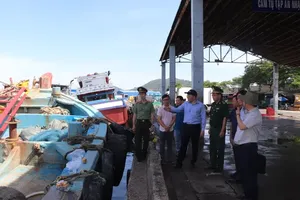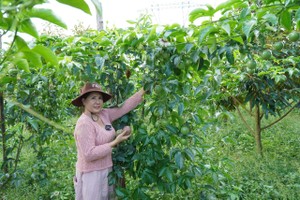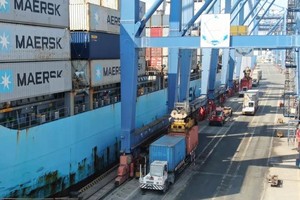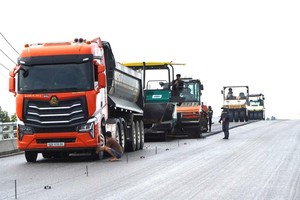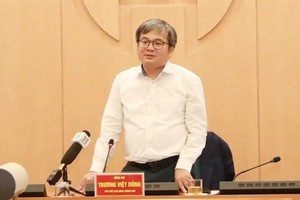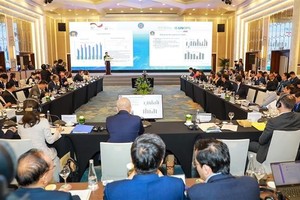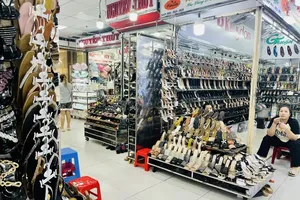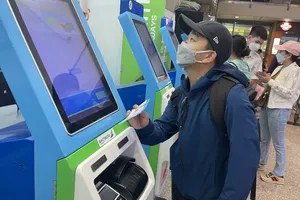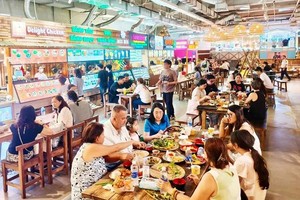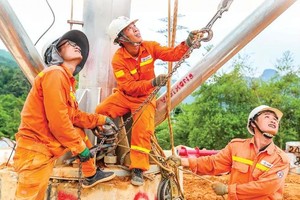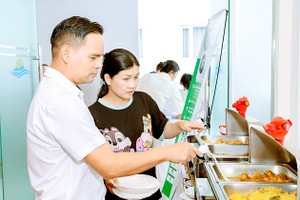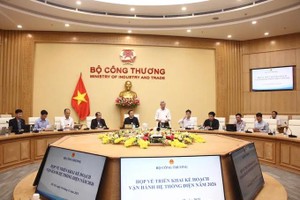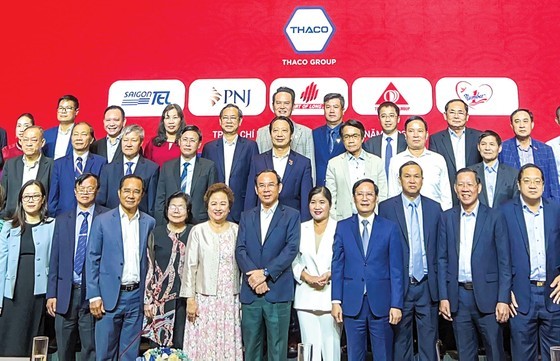 |
HCMC leader with delegates at the conference. (Photo: SGGP) |
The Vietnam Chamber of Trade and Industry (VCCI), on February 11, held a meeting on the occasion of the 2023 Lunar New Year, with the attendance of Mr. Nguyen Van Nen, Secretary of the HCMC Party Committee; Mr. Phan Van Mai, Standing Deputy Secretary of the HCMC Party Committee, Chairman of the People's Committee of HCMC; leaders of ministries, agencies, six provinces and cities in the Southeast region, and typical Vietnamese enterprises in 2022.
Many bottlenecks
Enterprises focused on analyzing the advantages, difficulties, limitations, and inadequacies encountered by seven Southeastern provinces and proposed many solutions to develop the regional economy.
Mr. Dau Anh Tuan, Deputy Secretary General of VCCI, said that the Southeast region is home to 147 industrial parks (IPs), accounting for 57 percent of the country's IPs, mainly concentrating in Dong Nai, Binh Duong, Ho Chi Minh City, and Long An. This area is also home to important transport infrastructure projects, such as Tan Son Nhat Airport, Long Thanh Airport (under construction), Cai Mep-Thi Vai Deep-Water Port, HCMC-based seaports, and Dong Nai Port.
This is a key import-export area as there are 13 road border gates, including four international border gates, namely Hoa Lu, Xa Mat, Moc Bai, and Tan Nam; three main border gates, namely Hoang Dieu, Loc Thinh, and Phuoc Tan; and six sub-border gates, namely Tan Tien, Ka Tum, Tong Le Chan, Vac Sa, Chang Riec, and Ta Nong. In addition, there are about 14,800 enterprises providing logistics services, accounting for 49.2 percent of the total number of logistics enterprises nationwide.
The Southeastern provinces contribute nearly 32 percent of the country's GDP. In 2022 alone, the proportion of foreign investment capital in the region accounted for nearly 40 percent, and the proportion of exports accounted for 35.38 percent of the whole country. The region's contribution to State budget revenue reached 37 percent. HCMC contributed the largest with 26.5 percent to the State budget revenue.
In the opposite direction, the Southeast region is facing bottlenecks in infrastructure, mechanisms, and policies, which greatly hinder regional economic growth. In particular, the transport infrastructure fails to keep up with the requirements of economic development, including roads, waterways, and airways. Planned projects for inter-regional connectivity, such as highways and ring roads, are slow to implement.
Cat Lai is considered the largest container port in the Southeast region. However, the road leading to this port experiences frequent congestion, particularly during peak hours. The logistics centers, ICDs, and distribution centers are still dispersed and lack coordination. Additionally, the area is facing increasing environmental pollution, and businesses are struggling with complicated tax and land procedures.
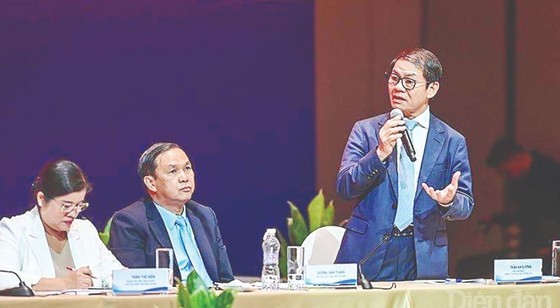 |
Mr. Tran Ba Duong, Chairman of the Thaco Management Board, expresses his opinion on removing difficulties for businesses at the conference. (Photo: SGGP) |
Huge investment space
Mr. Dau Anh Tuan suggested that in 2023, the Government, relevant ministries, and agencies should focus on applying synchronous solutions to solve difficulties for the region. Spec, the regional linkage should be promoted comprehensively, with the priority being infrastructure development; action plans on green economic development and environmental protection should be paid more attention to; the public governance quality improvement, the business environment facilitation, the public administration quality improvement should be monitored, evaluated, and taken measures to promote the implementation quality at the department and district levels.
Localities must also be transparent in providing information about the government's activities, combined with enhancing interaction and dialogue with people and businesses; implement programs to encourage innovation and digital transformation in enterprises; have programs to support start-ups and build business incubator models, he added.
Speaking at the conference, Mr. Phan Van Mai, Chairman of the People's Committee of HCMC, emphasized that in Resolution No.24-NQ/TW dated October 7, 2022 of the Politburo on socio-economic development and assurance of national defense and security in the Southeast region to 2030, with a vision to 2045 and Resolution No.31-NQ/TW of the Politburo on orientations and tasks for the development of HCMC to 2030, with a vision to 2045, the Central Government had assigned HCMC to implement six major projects.
These six projects include building an international exhibition center; building a mechanism and forming an international financial center in HCMC - an important capital channel for the region and the world; building HCMC into a center connecting with technology exchanges, thereby connecting with innovation centers; building a container transshipment port in Can Gio.
The remaining ones are forming industrial, urban, service, and logistics belts along ring roads No.3 and No.4, combined with building expressways between HCMC and Moc Bai (Tay Ninh), Chon Thanh, Long Thanh, and Trung Luong My Thuan; and developing the industrial and urban chain Moc Bai - HCMC - Cai Mep. In addition, HCMC has been urging the implementation of many other projects. This is considered a huge investment space for domestic enterprises.
Not only that, in 2023, HCMC has set an economic growth target of 7.5-8 percent. To achieve the above objectives, many breakthrough policies have been considered and resolved by the central government and functional ministries. HCMC leaders pledged to stand with businesses to propose the issuance of appropriate breakthrough policies to remove obstacles for enterprises in the investment process.
In the opposite direction, the city appeals to the business community to join hands to invest and effectively implement the above goals and projects. HCMC also wants to select some typical enterprises to support the improvement of the development scale. Therefore, the city needs enterprises to contribute ideas on solutions, mechanisms, and policies to carry out this matter.
